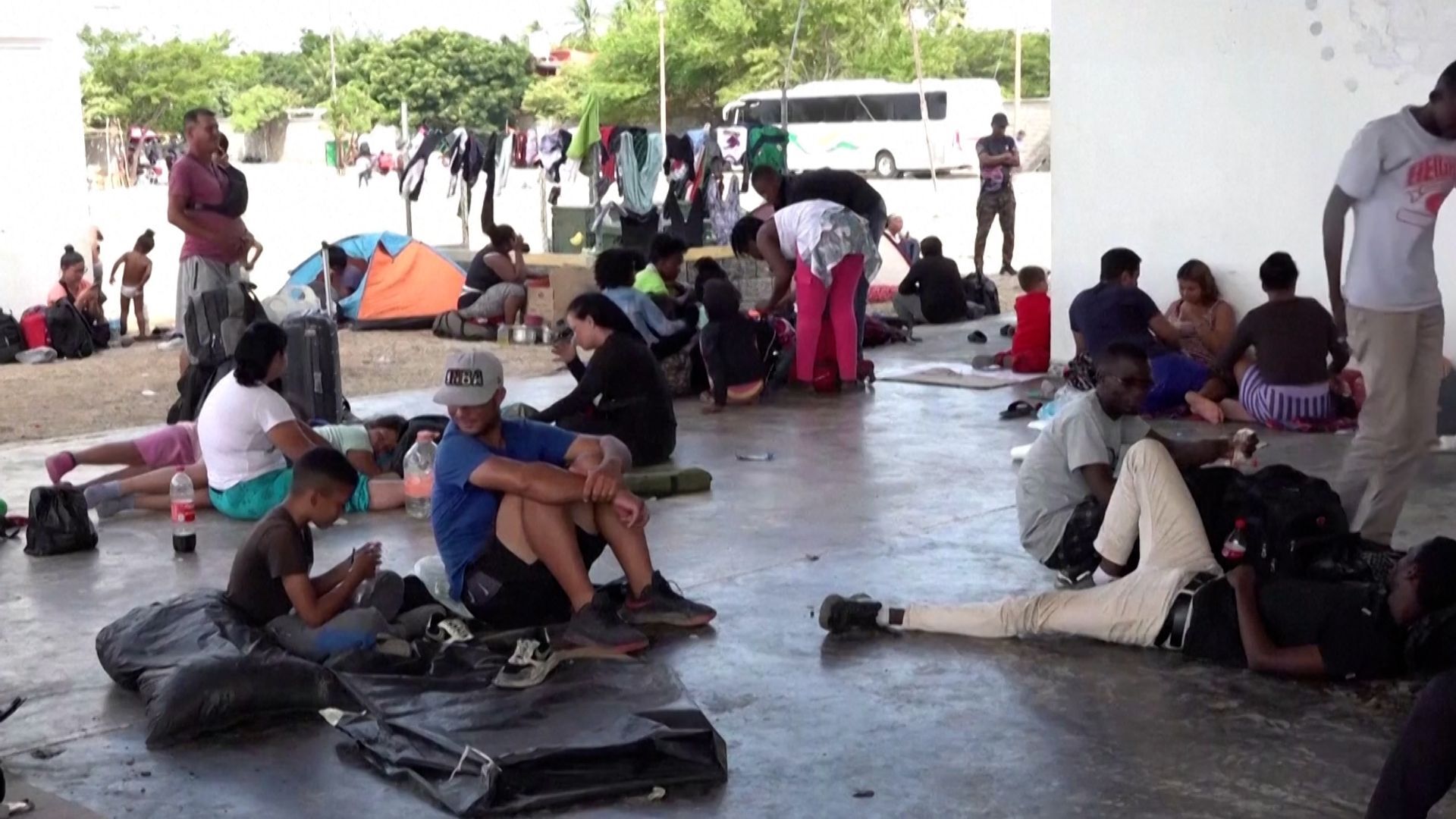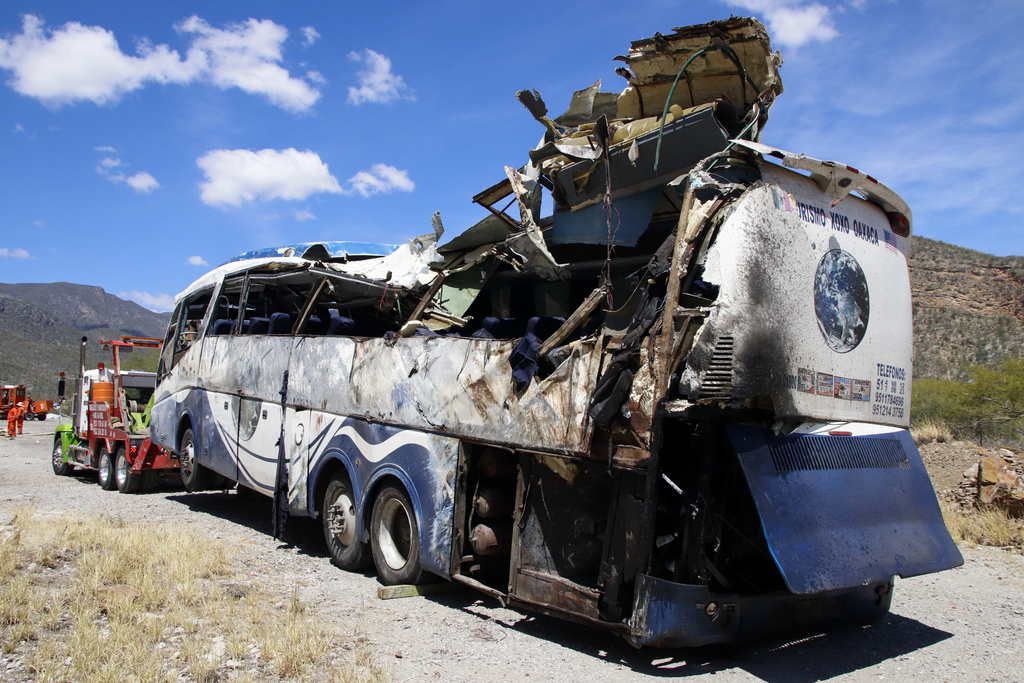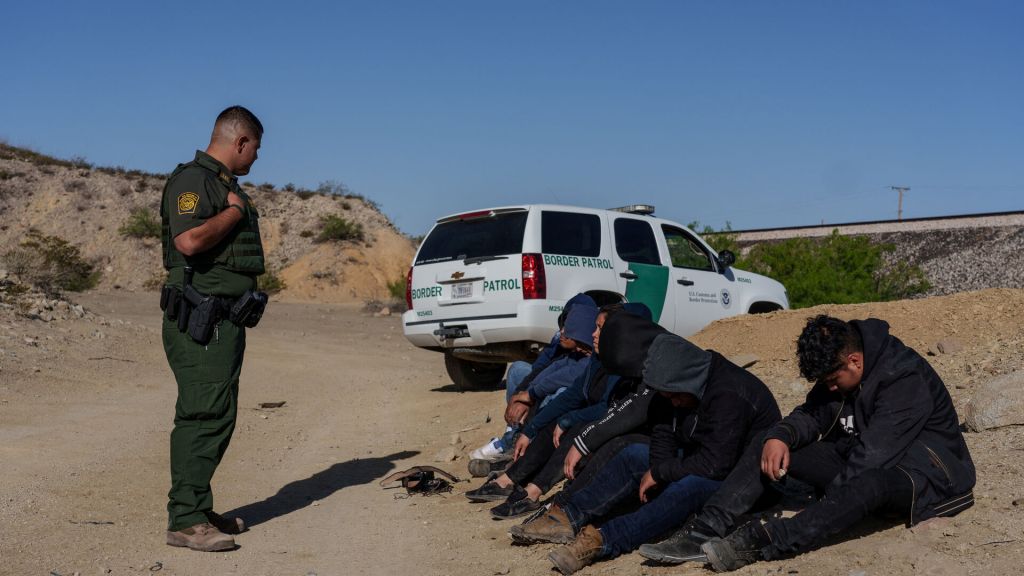
Mexico busing migrants north despite vow to help US alleviate border crisis
By Lauren Taylor (Anchor, Reporter), William Jackson (Producer), Zachary Hill (Editor)
Near Mexico’s southern border, hundreds of families wait for buses headed north to Mexico City. It’s just one stop on a nearly 1,800-mile migration into the United States.
This is a new stop. Buses are available for $80 a ticket to families who may or may not have appointments with immigration officials.

Download the SAN app today to stay up-to-date with Unbiased. Straight Facts™.
Point phone camera here
Mexican officials opened the site last month hoping to reduce the risks migrants face traveling north. However, the move appears to be having deadly consequences.
The most recent bus crash killed at least 16 Venezuelan and Haitian migrants. It departed from an immigration center in southern Mexico. The move is also in direct opposition to recent agreements with the U.S.

“Almost all of them pass through Mexico, and we must take care of migrants and protect them, but we must avoid an increase in the migrant flux because there is a risk,” Mexico President Andres Manuel Lopez Obrador said.
The Mexican government’s migration authority said it has deployed over 260 buses and vans to disperse over 8,000 migrants from the southern city of Tapachula, near the border with Guatemala, to other parts of the country.
Mexican authorities had promised to help deport certain migrants to their countries of origin, not help them seek asylum.
“We will continue to take strong actions and measures, including efforts already in place about assisted returns, coordinating the dismantlement of trafficking, human trafficking network,” Mexican Secretary of Foreign Affairs Alicia Bárcena Ibarra said at a joint press conference.
Bárcena Ibarra added that Mexico receives about 6,000 migrants daily at its southern border, with 1,500 crossing the Darien gap from Colombia, and more than 8,000 people arriving at the country’s northern border daily.
In a statement, Mexico’s National Migration Institute didn’t specify when the deportations would begin or how long they would last. Instead, it emphasized its intention to initiate negotiations with neighboring countries to ensure the orderly repatriation of its citizens to their respective countries.
The institute added from January to September 2023, federal immigration agents have rescued over 1.4 million migrants. More than 788,089 of them have been returned to their countries.
Government officials take action
This move has sparked action by senior government officials from both countries to congregate during the third U.S.-Mexico High-Level Security Dialogue — a chance for officials to promote binational safety and security.
The U.S.-Mexico High-Level Security Dialogue is essential to our prosperity and competitiveness. The United States and Mexico must continue to work together to address our top security priorities, including the synthetic drug threat, arms trafficking, and border security. pic.twitter.com/Kj46yzvOAo
— Secretary Antony Blinken (@SecBlinken) October 5, 2023
Secretary of State Antony Blinken, Department of Homeland Security Secretary Alejandro Mayorkas and U.S. Attorney General Merrick Garland will join Mexican government counterparts. It’s a joint meeting of the U.S.-Mexico Bicentennial Framework for Security, Public Health and Safe Communities.
“For our part, the United States is increasing refugee resettlement and we’re expanding legal pathways,” Blinken said. “Including launching our Safe Mobility initiative, so that people can find out whether they’re eligible to come to the United States from their own countries without having to make the journey to our borders.”
Since 2008, under the framework, $3 billion in aid has been allocated to Mexico. The aid addresses issues related to transnational organized crime and human trafficking.
According to the U.S. Government Accountability Office (GAO), this initiative encompasses various major U.S. contributions, including personnel training and checkpoint equipment aimed at addressing Mexico’s security challenges.
Other programs have focused on providing training and assistance to Mexican officials from the justice sector, border security, military and law enforcement. Mexico has 54 migration stations throughout its 32 states.

Customs and Border Protection (CBP) representatives have offered Mexican authorities assistance to address the immigration issue at airports and train stations to reduce the numbers of people who use these routes.
U.S. relations with Mexico
The growing relationship relies on Mexico to help manage cross-border crime and migrant smuggling, while Mexico relies on the U.S. to mitigate the flow of firearms into Mexico and decrease U.S. demand for drugs.
Despite ongoing security assistance, safety in Mexico has significantly worsened over the last 15 years. The United Nations says between 2007 and 2021, the homicide rate in Mexico more than tripled. Deaths rose from eight homicides to 28 per 100,000 people.
According to Mexico, fentanyl seizures have topped nearly 25% of the world’s supply. Simultaneously, more than 200,000 firearms enter Mexico every year in return.
Unbiased news.
Directly to your inbox. Free!
Learn more about our emails. Unsubscribe anytime.
By entering your email, you agree to the Terms & Conditions and acknowledge the Privacy Policy.
Actions taken by U.S. government
The Department of Homeland Security has announced executive actions allowing border wall construction to continue in southern Texas to mitigate the migration surge.
In addition, DHS has expanded the Family Expedited Removal Management (FERM) program. The program expidites the removal of families without a lawful basis to remain. Families are placed into expedited removal proceedings to occur within 30 days. Launched in May, this program has processed over 1,600 families and continues to scale up.
Related Stories
NEAR MEXICO’S SOUTHERN BORDER, HUNDREDS OF FAMILIES WAIT FOR BUSES HEADED NORTH TO MEXICO CITY. ONE STOP ON A NEARLY 18-HUNDRED MILE MIGRATION INTO THE UNITED STATES.
THIS STOP IS A NEW ONE HOWEVER. MEXICO OFFERED UP THE TRANSPORTATION AT 80-DOLLARS A TICKET FOR FAMILIES WHO MAY OR MAY NOT HAVE APPOINTMENTS WITH IMMIGRATION OFFICIALS AT THE U-S BORDER.
MEXICAN OFFICIALS OPENED THE SITE LAST MONTH.
PART OF AN EFFORT TO REDUCE THE RISKS FACING MIGRANTS.
AND TO EASE PRESSURE ON THEIR OWN PUBLIC TRANSIT SYSTEM.
BUT THE MOVE APPEARS TO BE HAVING DEADLY CONSEQUENCES.
RECENT CRASHES ARE ESCALATING THE ISSUE. The MOST RECENT BUS crash killed at least 16 Venezuelan and Haitian migrants after it departed AN IMMIGRATION CENTER IN SOUTHERN MEXICO. THE MOVE IS ALSO IN DIRECT OPPOSITION OF RECENT AGREEMENTS WITH THE U-S.
(Andres Manuel Lopez Obrador, Mexican President)
“Almost all of them pass through Mexico and we must take care of migrants and protect them, but we must avoid an increase in the migrant flux because there is a risk.”
MEXICAN AUTHORITIES HAD PROMISED TO HELP DEPORT CERTAIN MIGRANTS TO THEIR COUNTRY OF ORIGIN – NOT HELP THEM SEEK ASYLUM IN THE U-S.
(Alicia Bárcena Ibarra, Mexican Secretary of Foreign Affairs)
“We will continue to take strong actions and measures, including a few efforts already in place about assisted returns, coordinating the dismantlement of trafficking, human trafficking networks.”
Barcena Ibarra added that MEXICO RECEIVES ABOUT 6-THOUSAND MIGRANTS DAILY AT ITS OWN SOUTHERN BORDER; 15-HUNDRED ARE CROSSING THE DARIEN GAP FROM COLOMBIA AND MORE THAN 8-THOUSAND PEOPLE WILL ARRIVE AT THEIR NORTHERN BORDER DAILY.
THIS HAS SPARKED ACTION BY SENIOR GOVERNMENT OFFICIALS FROM BOTH COUNTRIES.
SECRETARY OF STATE ANTONY BLINKEN, DHS SECRETARY ALEJANDRO MAYORKAS, U-S ATTORNEY GENERAL MERRICK GARLAND ARE JOINING THEIR MEXICAN GOVERNMENT COUNTERPARTS TO WORK ON A NEW PLAN.
(Antony Blinken, Secretary of State)
“For our part, the United States is increasing refugee resettlement and we’re expanding legal pathways, including launching our Safe Mobility initiative, so that people can find out whether they’re eligible to come to the United States from their own countries without having to make the journey to our borders.”
SINCE 2008, UNDER THE BICENTENNIAL FRAMEWORK formerly the merida initiative, $3 BILLION IN AID HAS BEEN ALLOCATED TO MEXICO TO ADDRESS ISSUES RELATED TO TRANSNATIONAL ORGANIZED CRIME, ENHANCED BORDER SECURITY, AND REDUCED DRUG TRAFFICKING.
DESPITE ONGOING SECURITY ASSISTANCE, SAFETY IN MEXICO HAS SIGNIFICANTLY WORSENED OVER THE LAST 15 YEARS. BETWEEN 2007 TO 2021, THE HOMICIDE RATE HAS MORE THAN TRIPLED, ACCORDING TO THE UNITED NATIONS.
ACCORDING TO MEXICO’S TOP OFFICIALS, FENTANYL SEIZURES HAVE TOPPED NEARLY 25% OF THE WORLD’S SUPPLY WHILE MORE THAN 200-thousand FIREARMS ENTER MEXICO EVERY YEAR IN RETURN.
DESPITE DANGEROUS CONDITIONS, MIGRANTS ARE STILL TRYING TO REACH THE UNITED STATES’ SOUTHERN BORDER IN RECORD NUMBERS. PANAMA HAS DESCRIBED THE SITUATION AS A THREAT TO NATIONAL SECURITY WHILE COSTA RICA HAS DECLARED A STATE OF EMERGENCY.
Unbiased news.
Directly to
your inbox.
Free!
MOST POPULAR
-
 AP Images
AP Images
N. Korea hackers steal military secrets, hit Air Force bases, NASA, US says
Watch 1:54
12 hrs ago
-
 Getty Images
Getty Images
A convicted child rapist is competing in Paris Games, many want to know why
Watch 1:55
15 hrs ago
-
 AP
AP
Barack and Michelle Obama endorse Kamala Harris for president
Watch 1:33
17 hrs ago
-
 Reuters
Reuters
Attacks disrupt trains ahead of Olympics opening ceremony
Watch 9:44
18 hrs ago


